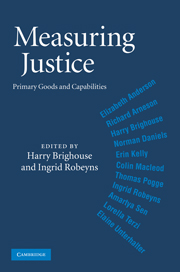Crossref Citations
This Book has been
cited by the following publications. This list is generated based on data provided by Crossref.
Crocker, David A.
and
Robeyns, Ingrid
2009.
Amartya Sen.
p.
60.
Alkire, Sabina
2010.
Human Development: Definitions, Critiques, and Related Concepts.
SSRN Electronic Journal,
Unterhalter, Elaine
2010.
Global Inequalities and Higher Education.
p.
91.
2010.
Books Received.
Philosophy,
Vol. 85,
Issue. 2,
p.
311.
Hartley, Christie
2011.
Disability and Justice.
Philosophy Compass,
Vol. 6,
Issue. 2,
p.
120.
Alkire, Sabina
2011.
Multidimensional Poverty and Its Discontents.
SSRN Electronic Journal,
Alkire, Sabina
2011.
Mesurer la pauvreté multidimensionnelle : les limites.
Revue d'économie du développement,
Vol. Vol. 19,
Issue. 2,
p.
61.
Hodgett, Susan
and
Clark, David
2011.
Capabilities, Well-Being and Multiculturalism: A New Framework for Guiding Policy.
International Journal of Canadian Studies,
p.
163.
Hart, Caroline Sarojini
2012.
The capability approach and education.
Cambridge Journal of Education,
Vol. 42,
Issue. 3,
p.
275.
McCormick, Peter
2012.
Aesthetics Tomorrow: Re-Contextualizations?.
Diogenes,
Vol. 59,
Issue. 1-2,
p.
118.
Mejía Cubillos, Javier
2012.
Ética y Justicia: Reflexiones a partir de The Idea of Justice de Amartya Sen (Ethics and justice: Reflections on The Idea of Justice by Amartya Sen).
SSRN Electronic Journal,
Mccormick, Peter
and
Grenaudier-Klijn, France
2012.
L'esthétique recontextualisée.
Diogène,
Vol. n° 233-234,
Issue. 1,
p.
165.
Børhaug, Frédérique Brossard
2012.
Rethinking Antiracist Education in the Light of the Capability Approach.
Journal of Human Development and Capabilities,
Vol. 13,
Issue. 3,
p.
397.
Brighouse, Harry
2013.
The International Encyclopedia of Ethics.
Moss, Jeremy
2013.
The Foundations of Well‐Being.
Australian Economic Review,
Vol. 46,
Issue. 1,
p.
62.
Brooks, Thom
2013.
The International Encyclopedia of Ethics.
2013.
The Blackwell Guide to Ethical Theory.
p.
412.
Watene, Krushil
2013.
Nussbaum's Capability Approach and Future Generations.
Journal of Human Development and Capabilities,
Vol. 14,
Issue. 1,
p.
21.
Gainer, Mitch
2013.
Assessing Happiness Inequality in the Welfare State: Self-Reported Happiness and the Rawlsian Difference Principle.
Social Indicators Research,
Vol. 114,
Issue. 2,
p.
453.
Munsaka, Edson
and
Charnley, Helen
2013.
‘We do not have chiefs who are disabled’: disability, development and culture in a continuing complex emergency.
Disability & Society,
Vol. 28,
Issue. 6,
p.
756.



